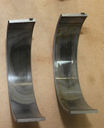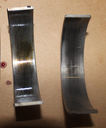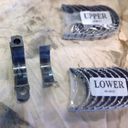 -- Better Bearings for your BMW
-- Better Bearings for your BMW -- Better Bearings for your BMW
-- Better Bearings for your BMW| BMW Bearings | Calico, VAC, WPC | BE Bearing Design | Buy BE Bearings | Contact Us |
| Explains engine failures | Previous attempts and stopgap measures | Our bearings aren't a stopgap, they're a fix | Custom bearing selection and purchasing details | Who are we and what do we do here? |
|
1
|
2
|
3
|
4
|
|
|
|
|
|
|
|
|
|
|
|
5
|
6
|
7
|
8
|
Using this formula will provide a safe starting point for most applications.
For High Performance engines it is recommended that .0005” be added to the
maximum value determined by the above calculation. The recommendation for
our 2.000” shaft would be .0025” of clearance.
...
High Performance engines on the other hand, typically employ greater bearing
clearances for a number of reasons. Their higher operating speeds result in
considerably higher oil temperatures and an accompanying loss in oil
viscosity due to fluid film friction that increases with shaft speed.
Increased clearance provides less sensitivity to shaft, block, and
connecting rod deflections and the resulting misalignments that result from
the higher levels of loading in these engines. Use of synthetic oils with
their better flow properties
can help to reduce fluid film friction.
...
Use of these coated bearings may result in slightly less clearance than the
uncoated CLEVITE 77® high performance parts for the same application. This
will typically be in the range of .0005.” This is because the coating,
although expected to remain in place during service, is considered to be
somewhat of a sacrificial layer. Some amount of the coating will be removed
during break-in and operation, resulting in a slight increase in clearance.
Every manufactured part has a manufacturing tolerance range that goes along with it. The parts are supposed to match the specification, but manufacturing variances will lead to these tolerance differences. When one part is on its outside tolerance, it's probably no big deal. When two parts are at the opposite of their tolerance limits, it can lead to catastophic failure as I will show.
Oil clearance is affected by three different parts, each having their own tolerance. Each of these specifications and tolerances were either specified by BMW, or measured in the field using multiple example components to build a database of component tolerance.
The bearing clearance is calculated as the difference between the (connecting rod big end bore, two times the bearing thickness, and the connecting rod journal diameter. This is typically measured with a bore gauge when the bearings are assembled in the connecting rod, and size of the connecting rod journal is subtracted from the value found on the bore gauge.
When we put all nominal parts together, here's how they stack up:
That's already dangerously too small and almost half the Clevite recommended clearance. So let's look at what happens when we put all of the parts together at their maximum stack up (for minimum oil clearance). Keep in mind each of these parts is within it's allowed tolerance limit and would pass inspection. But look what happens when you put them all together.
An S65/S85 engine with only 0.00060 inch clearance is less than one-quarter the Clevite recommended clearance. Finally let's look at what happens when we put all of the parts together at their minimum stack up (for maximum oil clearance)
At miniumum stack up, the S65/S85 engine will last a very long time, even using the very thick 10W60 oil specified by BMW.
It is believed at maximum stack up, coupled with thick 10W60 oil leads to premature engine failures. These are the engines believed to blow with 25000 miles or less. A few engines have blow with 6000 miles or less; and one engine blew with only 1500 miles. The solution to this problem is increased bearing clearance.
When this problem first came to light, many people begin replacing their rod bearings. The following pictures are evidence of oil starvation, and bearing clearnce too small.

|
1
|
2
|
3
|
4
|
5
|
6
|
7
|
8
|
|
1
|
2
|
3
|
4
|
5
|
6
|
7
|
8
|









|
1
|
2
|
3
|
4
|
5
|
6
|
7
|
8
|